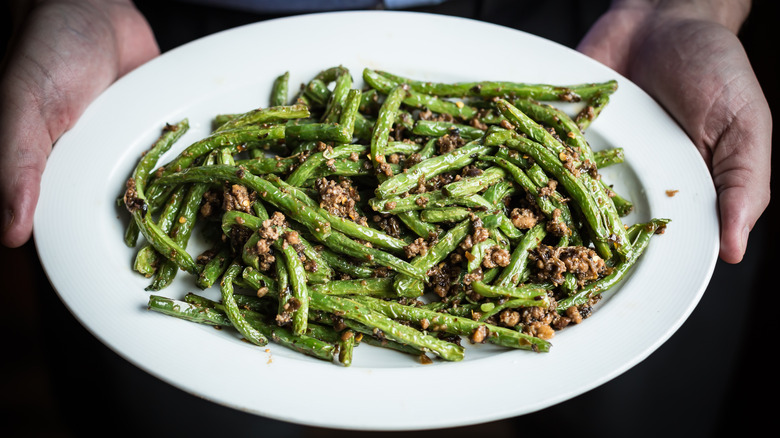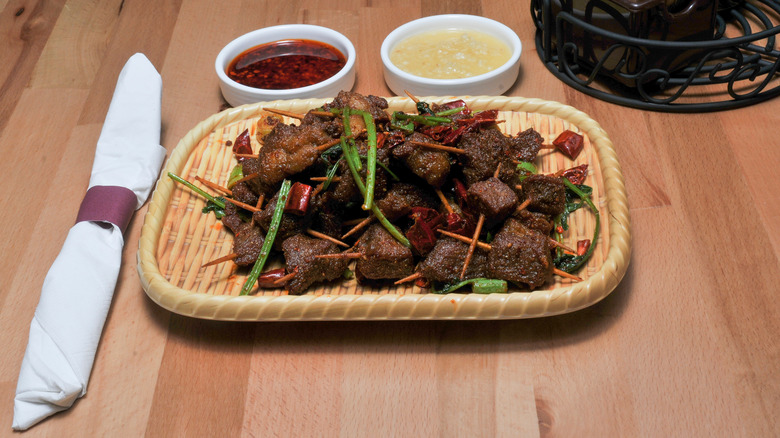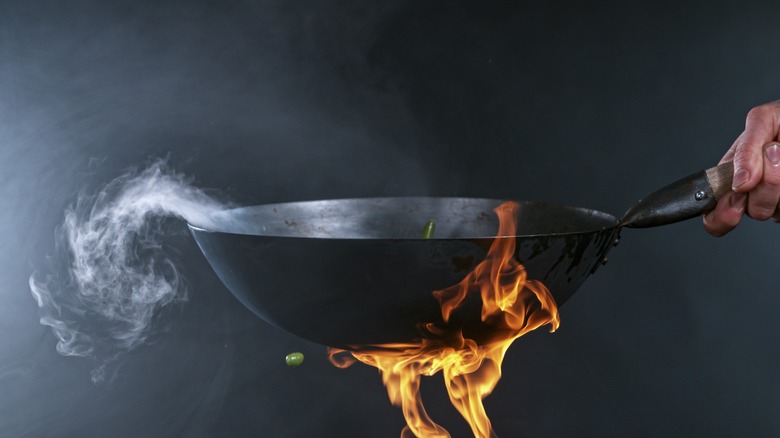Dry-Frying Your Food Is The Key For Amazing Flavor And Texture
When you hear Sichuan (also Szechuan) cuisine, the first thing that might pop into your head is how spicy it is, or how tingly-hot Sichuan peppers are. But this ancient cuisine, one of China's eight major culinary schools, has many dishes that contain neither red chilies nor Sichuan peppers, such as fragrant tea-smoked duck. Sichuan cuisine has also developed several distinct standalone cooking techniques; chief among them might be a type of food preparation called dry-frying, or sometimes dry-braising. If you've ever had the addictively delicious, garlicky, blistered green bean Sichuan dish called gan bian si ji dou, you've eaten (and likely loved) dry-fried food.
Sichuan dry-frying shouldn't be confused with air frying, which is a completely different cooking method. Dry-frying requires a wok (or skillet), a neutral, high smoke-point cooking oil, and plenty of heat. You can dry-fry almost anything, from vegetables such as the aforementioned green beans or eggplant to pieces of meat. The term itself doesn't refer to the absence of oil; rather, it refers to the lack of any batter on the food. The goal is to get the main ingredient of the dish as seared as possible, drying it out and creating a crusty chew. Once that's accomplished, aromatics and other vegetables are added at the end of the cooking process.
The basics of dry-frying food
Dry-frying is distinct from other oil-based cooking techniques such as sautéing or deep frying because of the target texture of the featured ingredient. Sichuan dry-fried beef,for example, should be fragrant with a dry texture. For the dish, thin strips of marinated beef are added to very hot oil (about 375 degrees Fahrenheit) and dry-fried for several minutes. Excess oil is removed once most of the meat's internal moisture has evaporated, and it's well-browned and almost crisp. It's at this point when aromatics like garlic, ginger, and chili flakes are added; flavors that the beef absorbs instead of simply being coated by them.
Dry-fried vegetables turn out blistered and crisp and require very little preparation besides thorough drying and maybe a starch coating. Animal proteins, however, need to spend some time in a marinade which often contains oil — which some people believe helps the meat stay tender. Traditional Sichuan dry-frying marinades can be quite simple or made elaborate with spices and aromatics like ginger and scallions, but almost all of them include richly flavored Shaoxing rice cooking wine.
The secrets to successful dry-frying
Woks are recommended for dry-frying because they heat up quickly and allow for ease of stirring as well as food removal. Whatever food you're dry-frying, make sure to cut it into uniformly sized pieces so they'll cook consistently. Thoroughly blot dry your washed vegetables before dry-frying them, to reduce the risk of splatter burns. When preparing meat such as lamb or beef for dry-frying, be sure to cut against the grain to minimize chewiness, and do not overcrowd the wok, which can result in steaming rather than drying. Work in batches if necessary.
Whatever cooking happens at the end of your dry-fried dish, do it quickly. In the case of gan bian si ji dou, the dry-fried green beans are hit with a flash stir-fry of garlic, red pepper flakes, and add-ins like capers, before being promptly turned out on the plate. Meat dishes like toothpick lamb or dry-fried beef require removing the meat and excess oil before a similar stir-frying process with the additional ingredients, which should be done in short order so that nothing has a chance to cool off too much. Just as with any other stir-fry, be sure to have every ingredient prepped and ready to go before heating your wok for a Sichuan dry-fry. The indefinable aromatic quality of Wok Hei and a deliciously different dining experience is sure to follow.


